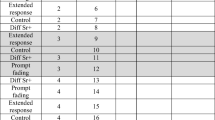Abstract
Behavior analysts are frequently responsible for teaching concepts and operations. Whether teaching in academia, training employees within corporations, working with young learners, or serving disabled learners, behavior analysts primarily find themselves in an instructional position relaying information from themselves to others. They often design how this information is transmitted to the learner so that the person can operate upon the world proficiently with the new concept or operation. As a result, behavior-analytic instructional design has spent much time piecing together optimal ways of making instruction effective. Nevertheless, these instructional design practices are not widely disseminated or adapted to everyday clinical practice. Therefore, the current article proposes a comprehensive framework where a learner contacts different hierarchical instructional levels while establishing proficiency on each level before progressing toward the ultimate goal of the concept or operation. These levels include Discriminate, Generate, Operate, and Demonstrate. By progressing through this framework, the learner will apply and generalize the instructional concept or operation regardless of context and nuance.


Similar content being viewed by others
Notes
Throughout this article, we use the term "concept" generally, referring to concepts and conceptual structures, as defined by Susan Markle (1970).
References
Becker, W. C. (1974). Teaching concepts and operations, or how to make kids smart. In R. Ulrich, T. Stachnik, & J. Mabry (Eds.), Control of human behavior: Behavior modification in education, (Vol. 3., pp.). Scott, Foresman & Company.
Chadwell, M., Sikorski, J., Roberts, H., & Allen, K. (2019). Process versus content in delivering ABA services: Does process matter when you have content that works? Behavior Analysis: Research & Practice, 19(1), 14–22. https://doi.org/10.1037/bar0000143
Choi, E., & Johnson, D. (2022). Common antecedent strategies within organizational behavior management: The use of goal setting, task clarification, and job aids. Journal of Organizational Behavior Management, 42(1), 75–95. https://doi.org/10.1080/01608061.2021.1967834
Engelmann, S. & Carnine, D. (1991) Theory of instruction: Principles and applications (2nd ed.). ADI Press.
Gagné, R. M. (1985). The conditions of learning and theory of instruction. Holt Rinehart & Winston, Inc.
Greer, R. D., & Ross, D. E. (2008). Verbal behavior analysis: Inducing and expanding new verbal capabilities in children with language delays. Pearson Education.
Haughton, E. C. (1972). Aims: Growing and sharing. In J. B. Jordon & L. S. Robbings (Eds.), Let’s try doing something else kind of thing (pp. 20–39). Council for Exceptional Children.
Hieneman, M., Fefer, S., Isley, S., & Sieders, M. (2022). Helping your family thrive a practical guide to parenting. Brooks Publishing.
Johnson, K., & Bulla, A. (2021). Creating the components for teaching concepts. Behavior Analysis in Practice, 14(3), 785–792. https://doi.org/10.1007/s40617-021-00626-z
Johnson, K. R., & Layng, T. V. J. (1992). Breaking the structuralist barrier: Literacy and numeracy with fluency. American Psychologist, 47, 1475–1490. https://doi.org/10.1037/0003-066X.47.11.1475
Johnson, K. R., & Layng, T. V. J. (1996). On terms and procedures: Fluency. The Behavior Analyst, 19(2), 281–288. https://doi.org/10.1007/BF03393170
Johnson, K., & Street, E. M. (2013). Response to intervention and precision teaching: Creating synergy in the classroom. Guilford Press.
Johnson, K., Street, E. M., Kieta, A. R., & Robbins, J. K. (2021). The Morningside model of generative instruction: Building a bridge between skills and inquiry teaching. Sloan Publishing.
Kubina, R. (2012). Precision teaching book. Greatness Achieved Publishing.
Layng, T. V. J. (2019). Tutorial: Understanding concepts: Implications for behavior analysts and educators. Perspectives in Behavior Science, 42(2), 345–363.
Layng, T. V. J., Twyman, J. S., & Stikeleather, G. (2004). Engineering discovery learning: The contingency adduction of some precursors of textual responding in a beginning reading program. Analysis of Verbal Behavior, 20(1), 99–109. https://doi.org/10.1007/BF03392997
Mace, F. C., & Nevin, J. A. (2017). Maintenance, generalization, and treatment relapse: A behavioral momentum analysis. Education & Treatment of Children, 40(1), 27–42. https://doi.org/10.1353/etc.2017.0001
Markle, S. M. (1969). Good frames and bad: A grammar of frame writing. (2nd ed.). John Wiley & Sons.
Markle, S. M., & Tiemann, P. W. (1970). “Behavioral” analysis of “cognitive” content. Educational Technology, 10(1), 41–45.
Miller, A. S., & Spiker, S. (Hosts). (2021, June 9). ABA Pt. 3: Little Robots (213) [Audio podcast]. Why We Do What We Do. https://wwdwwdpodcast.com/episodes/2021/0609-episode-213-aba-pt-3-little-robots-why-we-do-what-we-do
Sandoval-Norton, A. H., Shkedy, G., & Shkedy, D. (2019). How much compliance is too much compliance: Is long-term ABA therapy abuse? Cogent Psychology, 6(1). https://doi.org/10.1080/23311908.2019.1641258
Skinner, B. F. (1968). The technology of teaching. Vintage Books.
Skinner, B. F. (1974). About behaviorism. Appleton-Century-Crofts.
Snyder, P. A., Rakap, S., Hemmeter, M. L., McLaughlin, T. W., Sandall, S., & McLean, M. E. (2015). Naturalistic instructional approaches in early learning: A systematic review. Journal of Early Intervention, 37(1), 69–97. https://doi.org/10.1901/jaba.1977.10-349
Stokes, T. F., & Baer, D. M. (1977). An implicit technology of generalization. Journal of Applied Behavior Analysis, 10(2), 349–367.
Tiemann, P.W., & Markle, S.M. (1991). Analyzing instructional content: A guide to instructional content (4th ed.). Stipes Publishing.
Twarek, M., Cihon, T., & Eshleman, J. (2010). The effects of fluent levels of Big 6 + 6 skill elements on functional motor skills with children with autism. Behavioral Interventions, 25(4), 275–293. https://doi.org/10.1002/bin.317
Vargas, E. A. (1982). Intraverbal behavior: The codic, duplic and sequelic subtypes. VB News, 1, 5–7. https://doi.org/10.1007/BF03392792
Author information
Authors and Affiliations
Corresponding author
Ethics declarations
Conflict of Interest
On behalf of the authors, the corresponding author states that there is no conflict of interest.
Rights and permissions
Springer Nature or its licensor (e.g. a society or other partner) holds exclusive rights to this article under a publishing agreement with the author(s) or other rightsholder(s); author self-archiving of the accepted manuscript version of this article is solely governed by the terms of such publishing agreement and applicable law.
About this article
Cite this article
Smith, K., Milyko, K., Fuller, T. et al. Utilizing a Discriminate-Generate-Operate-Demonstrate Framework for Instructional Design. Educ. Treat. Child. 47, 105–117 (2024). https://doi.org/10.1007/s43494-023-00115-8
Accepted:
Published:
Issue Date:
DOI: https://doi.org/10.1007/s43494-023-00115-8




